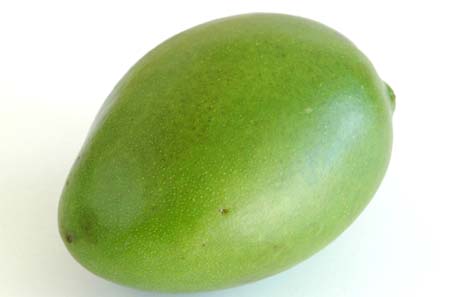
Maamidikaya (Unripe Green Mango) ~ For this week’s Indian Kitchen.
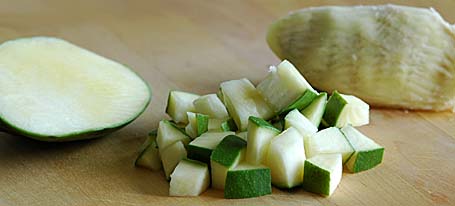
(Cut Green Mango and on the side is seed of the mango)
Recipes:


Recipes:
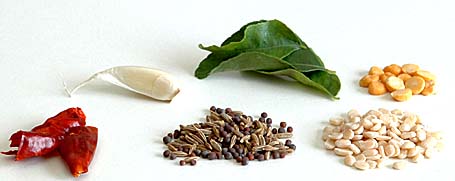
Popu rescues the dals and the curries from ‘bland’ hell. Simple technique, but it saves and uplifts them to spicy heaven. Almost all types of curries, chutneys, lentil preparations like dals, sambhars and rasams are enhanced by the addition of popu at the start or just before serving. The most common ingredients of popu or tadka are
1. Dried red chilli pieces (Endu Mirchi)
2. Garlic (Vellulli)
3. Curry leaves (Karivepaku)
4. Chana dal (Bengal gram, Sanaga pappu)
5. Urad dal (Black gram, Minapa pappu)
6. Mixture of Mustard seeds and Cumin (Avaalu+jeelakarra)
(listed according to arrangement in the photo above)
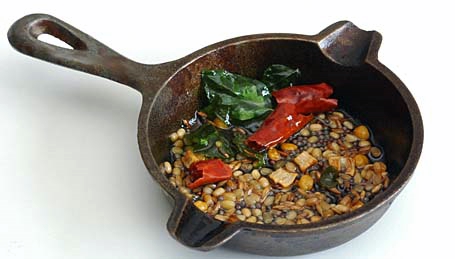
Popu or tadka (tiragamata) is toasting the listed ingredients in oil or ghee. Take oil or ghee in a small pan. The quantity ranges from a teaspoon to tablespoon for dals, sambars and curries. Heat to warm. Quickly add and toast curry leaves, dried red chilli pieces, garlic, chana dal and urad dal to red color. At the end add cumin and mustard seeds. When seeds start to pop, turn off the heat. Add the contents of the pan to the preparation. The quantity of above ingredients are usually a pinch, a dash, just few pieces and not much. All of them have excellent health benefits and popu or tadka provides a neat way to have them regularly through our meals. Multi vitamin pill everyday.
There are certain foods and occasions, where we avoid adding garlic. Examples are chitrannam (lemon rice),pulihora (tamarind rice) and daddojanam (yogurt rice) etc.
Fenugreek seeds (menthi),
hing or asafetida,
black peppercorn (miriyalu)
are also part of popu or tadka, but they are only added in a few, specific recipes.
To store all the ingredients of popu or tadka, every Indian kitchen has a spice box conveniently placed at hands reach in a kitchen drawer. And every Indian cook has her own way of arranging the ingredients in Popu dabba (spice box). Placing them all in separate little containers in one big box is not only convenient, but also saves lot of time by making the cooking little bit easy.
This is how I arrange my spice box:
So, do you own a spice box? How do you arrange your spice box?
Many Indian grocery stores carry ‘Spice Box’ or ‘Masala Dabba’. Depending on the box and containers size, the price varies from 10 to 20 dollars.
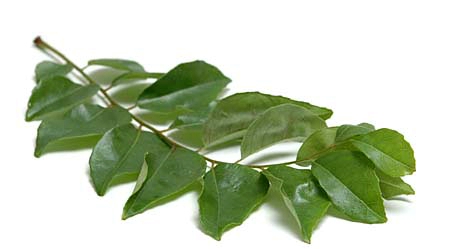
For this week’s Indian Kitchen, it is “curry leaves”. This aromatic fresh herb is native to India and is an essential ingredient in “popu or tadka“. The leaves when lightly fried in oil or ghee, release wonderful fragrance and when mixed with rice or with dals, enriches them by their unique appetizing aroma and essential oils.
The curry leaves are in light green color when young and are usually added as whole to the cooking. The mature leaves are dark in green, and are usually teared into two or three pieces or finely chopped before adding to hot oil. For each recipe, the number of leaves I usually add varies from 4 to 10. Some recipes I blogged so far, where curry leaves are a must – 1.Coconut chutney 2. Chitrannam (lemon rice) 3. Sambhar, just to name a few.
If you live in a warm climate, it’s really easy to grow this small deciduous plant. Plant a mature fresh sprig branch or small seedling/offshoots in mineral rich soil, water it daily and watch it flourish into a fragrant, pretty neat plant. It needs sunshine and lots of it.
You can find packets of fresh curry leaves either in fresh vegetable section, or in refrigerated area of your local Indian grocery shop. Usually priced at one dollar a packet, even less during summer times. If you ask me, they are the best bargain, or the most over priced item:) one can buy in US. Fresh leaves stay fresh at least for two to three weeks, when stored in refrigerator, sealed in a plastic bag. When left opened, they dry out easily. Dried leaves can be used in cooking, but the flavor of fresh curry leaves is superior and irreplaceable!
More about curry leaves:
Curry Leaf Heaven
The Goodness of Curry leaves!
Curry Leaves, different names – Source
Six essential spices for Indian cooking.
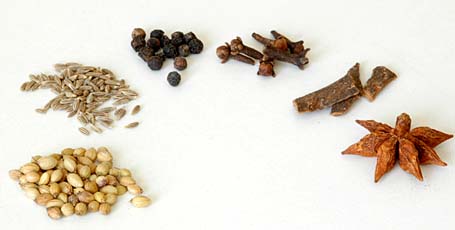
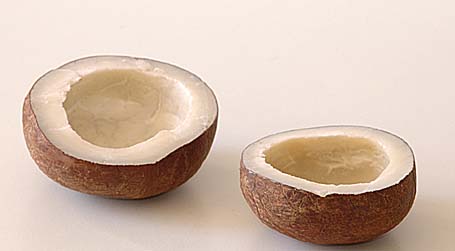
For this week’s Indian kitchen, I’m showcasing a unique Indian ingredient, “Ballari Coconut”. It’s a dried whole coconut, and the unique thing about it is how it is dried. Under hot summer sun, some selected whole coconuts are dried with coconut water inside so that the coconut meat can absorb all the coconut water while drying. This process makes the dried coconut very sweet. A completely different taste when compared to ordinary dried coconut, where the drying process is done after removing the coconut water.When cut into half (above image) and grated or powdered, Ballari coconut almost taste like sweetened, sugar added coconut flakes.
In our area, Nandyala (India), it’s called ‘Ballari coconut’. Because of the special process involved in making, it’s priced little bit high than the ordinary dried coconut. Due to high cost, it’s used mainly during special occasions like for preparing sesame laddus and as part of traditional ‘sare’ (care package) to married daughters from mothers etc.,
Are you aware of this type of dried coconut? If so, what do you call it at your place? Any feedback is much appreciated. Thanks!
it’s available in Indian grocery stores here in US. I saw it at Subji Mandi in New Jersey and also at Pittsburgh Indian grocery shop. Look for whole dried coconut instead of halved shells.
For more weekend food/herb blogging, check out Kalyn’s Kitchen.
Ripe guava:
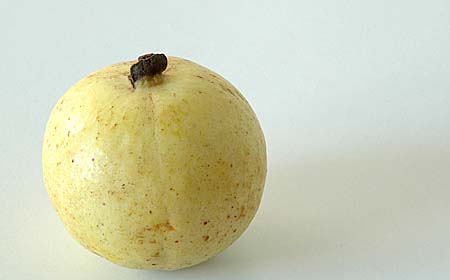
It’s has been a while since we saw and had a ripe guava. 6 years to be exact. They were not in season during our trips to Nandyala. But we got lucky in Toronto, Canada. Local Indian stores were carrying this precious Indian fruit and the real miracle is at a reasonable price.
One of life lessons, I learned is, its not good for health to feel nostalgic about home foods. But this fruit with its incredible fragrance, with just right amount of ripeness brought out symptoms of nostalgia. Eyes misted, mouth watered, brain couldn’t get enough of its smell and heart wanted more… .I don’t know when I’d have a taste of guava again, but for now, I enjoyed the fruit, feeling nostalgically delirious.
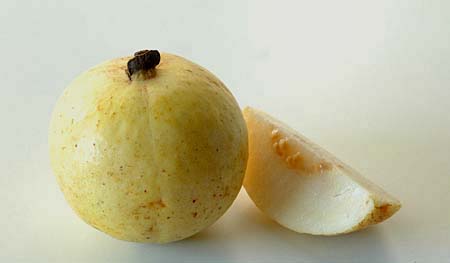
This cherished fruit with unique taste and fabulous fragrance when ripe is called Jamapandu in Telugu and ‘Guava, Amrud, Koiya Palam, Perakka and Peyara’ in other Indian languages. Ripening process makes the fruit go from hard to tender and skin colour also changes, from a shade of green to a shade of yellow. We usually eat the whole fruit including the skin and the tiny seeds, when ripe. Just sprinkle some salt, to give that perfect taste of salty sweetness. Pleasant but not flashy, both in looks and taste -that’s how I describe guava.
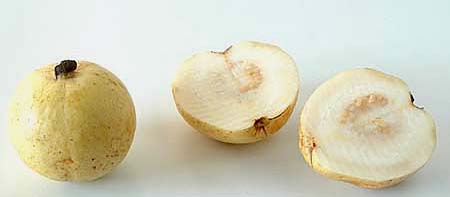
I am glad I was able to capture the image of ripe guava for my Indian kitchen series. Even though I gave up the idea of hosting ‘Indian kitchen’ here on my blog (very time consuming), instead, I created a Flickr group to share images of Indian ingredients and utensils so that food bloggers and foodies who don’t have blogs, but interested to participate, can share images. It can also used as a group pool, so that whenever we need a photo of some kitchen thing, we can link to the image in Flickr set, instead of doing google or yahoo image search. If you are interested, join the group and share your images of Indian kitchen.
Saffron (Kumkuma Puvvu):

India, Kashmir, hard work, awe and reverence.. these are things that come to my mind, whenever I use saffron in my cooking. It is produced in Kashmir, India. Harvesting is slow hard work which needs delicate touch. Awe and reverence… because I use it only in personally important and spiritually special occasions. Bold in color, subtle in flavor, precious saffron brings an ethereal touch.
In traditional sweets like laddu and payasam (Kheer) is where I add saffron to my cooking. Example is ‘saffron infused sabudana payasam’ that I prepared, celebrating my own space on the Net, the onset of My blog, ‘Mahanandi’.
Part of my Indian Kitchen, more about Saffron ~ here and here.
Spinach (Palak, Pala Kura)
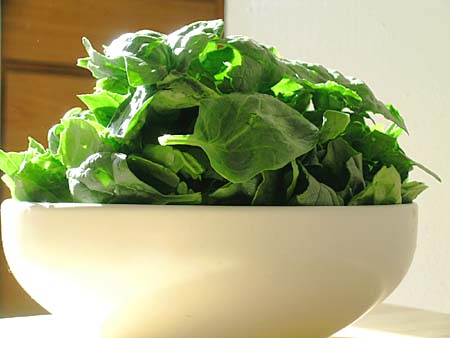
This green leafy vegetable is a must buy at least once a week, for me. Spinach dal and spinach curry are the most common ways, how I use this vegetable. Sometimes, when I am in a mood for fancy, restaurant kind of meal, I make the famous Palak Paneer. With rice, roti or as sandwich filler, I like my spinach.
For this weekend herb/food ingredient blogging –
It’s Time for Thyme at Kalyn’s Kitchen and 80th birthday party for her dad. Wow, congratulations Kalyn’s Dad and many more happy returns of the day!
Nature’s complete food – Dates at My Dhaba and also checkout Adarsh, the cute taste tester of My Dhaba.
Sam of Beck and Posh is requesting our prayers for Fred. Please send some goodwill towards her way. Thanks!

Indispensable to my cooking, I can’t imagine preparing food without this herb. More about Cilantro – here and here.
For this Weekend Herb Blogging, it’s Curly Parsley at Kalyn’s Kitchen and Keerai(Amaranth) at My Dhaba.
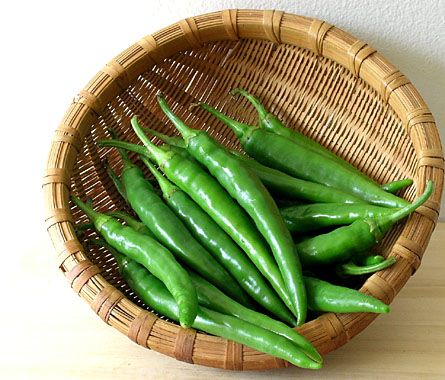
Recipe for Stuffed green chilli bajji is here.
For this weekend herb blogging, It’s Rosemary at kalyn’s Kitchen and her signatory, published recipe in Salt lake Tribune. That’s impressive.
Until after I moved out of my parents home to Hyderabad, I didn’t know about any other varieties of brinjals except these greenish white beauties. They are called Poluru Vankaayalu in Telugu. Vankaaya means Brinjal and Poluru is the name of the village, (near my home town Nandyala) in Andhra where they are grown exclusively. So the name Poluru Vankaayalu. Thanks to Thai and Vietnamese, I am able to purchase them here also in US.
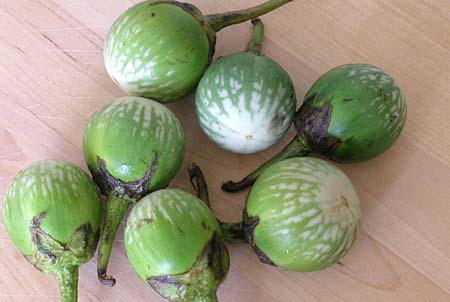
When cut open, brinjal filled with black seeds means it’s very ripe and not good for cooking, tastes bitter. The ones filled with white seeds, only they are used for curries and kurmas. They have mildly sweet and buttery taste when cooked and the greenish white skin outside tastes so delicious. Because they mature very rapidly, I always buy a lot. I have to throw away at least half of them because of black seeds. Curry cooked with the remaining white ones, is a rare treat that makes me remember my hometown tastes.
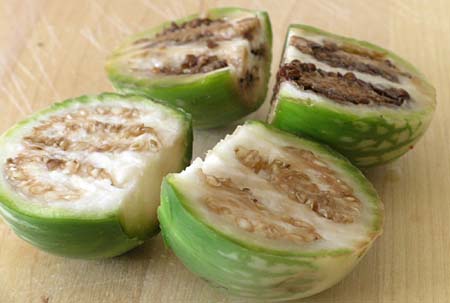
Recipes with Green Eggplant:
Stuffed Green Brinjal Curry
Brinjal-Potato Curry
Weekend herb blogging – It’ s Sage at Kalyn’s Kitchen
Freshly harvested raw peanuts, boiled in salted water – we grew up eating them and we both love them. They are one of the popular street foods in India. But they are hard to find here in US, particularly in the northeastern states. Imagine my surprise when I saw them at Subji Mandi, NJ during our recent trip.
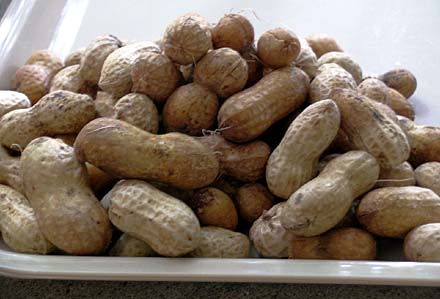
We bought 5 pounds, we couldn’t wait, ate half of them raw on our return trip. We cooked the remaining half in salted water. They are wonderfully tasty and we couldn’t get enough of them. We should have bought lot more. Perhaps next time, whenever that’s going to be.
For more weekend herb/food ingredient blogging, checkout Kalyn’s Kitchen.
Watermelon Seeds
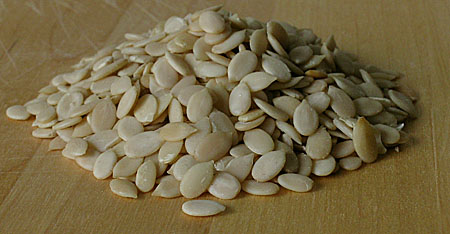
These beautiful watermelon seeds are rich in taste and don’t have any characterizing smell like sunflower and pumpkin seeds. They were our timepass snack when we were growing up. And in South India, they are added to betel nut(areca) mix (supari) as part of paan masala.
These days I am adding these seeds, spoonful of them to curries/kurmas. They bring subtle flavor and sweet nuttiness to whatever dish I add, love the taste of them.
Checkout for more weekend veggie/food ingredient blogging at kalyn’s Kitchen.
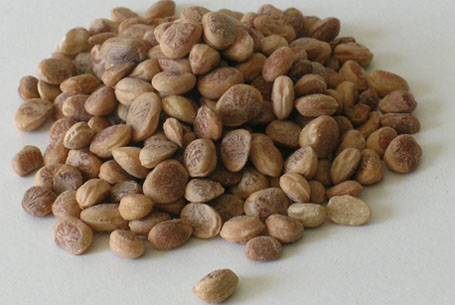
These nuts are called “Saara Pappu” in Telugu. They taste just like almonds and we usually add them in kheers, payasams and kulfis. I am curious to know their English Name, any help from fellow food bloggers and readers of this blog is greatly appreciated. Thanks!
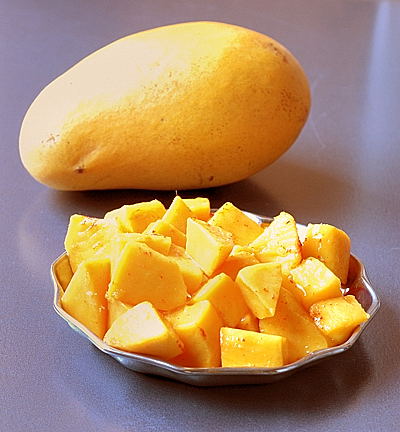
Namaste. Welcome to my website ~ Mahanandi. A showcase of my latest interest, that is recording the age-old recipes my family prepares at home in India.
Indian cuisine is one of the mother cuisines of the world and Indian cuisine is sustenance cooking at its best. In our day-to-day cooking, the local, humble ingredients are elevated through healthy, sophisticated cooking techniques to scrumptious dishes. The precious culinary traditions have been preserved and passed from generation to generation through word of mouth and daily hands-on-ingredients experience, without the need of fancy cooking schools, culinary degrees, cookbooks and recipe cards for so long. But the times are changing…
I am attempting this from my home in Ohio, US. I have come across a number of recipe sites, but I could not find any with pictures of ingredients or everyday meals. My hope is that Mahanandi with food photos will entertain and delight those who already knew the ingredients and recipes, also offers some level of interest and assistance to novice who loves and wants to try Indian cuisine.